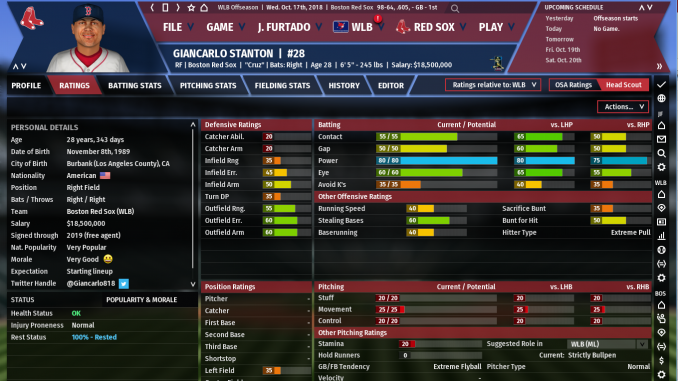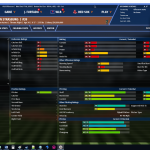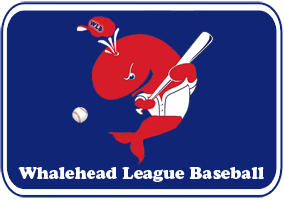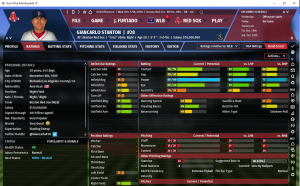
As I have mentioned in the Facebook group, to help people find information I’m posting some tutorial information.
IF YOU HAVE THE GAME ALREADY, take a look at this post. It’s something I found online. Although I’m not an OOTP expert, I’ve learned quite a bit already. As I learn more I will update the tutorials.
Batter Ratings
Contact = Not what you would normally think of when you see contract. It is actually a Projected Batting Average. (Generated from Avoid K, BABIP, and Home Runs ratings)
Gap = the ability of the player to hit the ball to the open spots in the OF, thus resulting in Doubles (and triples for fast guys).
Power = The ability of the player to hit the ball over the wall.
Eye = The ability for the player to draw walks.
Avoid K = Actual Contact Rate = The ability of the player to avoid getting struck out.
Other categories for the hitters:
Position Ratings = This is the middle box where it gives one single rating for each position the player knows how to play. It is effected by the box to the left of it, which has the players Range, Error, Arm and Turn DP.
Fielding Ratings
Range = How much ground the player can cover.
Error = How “Sure-Handed” the player is.
Arm = How strong/accurate the player’s throws are.
Turn DP = How effective the player is at turning a double play.
Ability – How well the Catcher fields his position.
Position Ratings are a product of that positions Range/Arm/Error/Turn DP (or Ability and Arm for Catchers) and the experience (rating 1-200, which is only visible in the editors screen). Experience is gained by the player playing that position.
(Note: Catchers aren’t rated individually for Range, Error and Turn DP. These are more or less rolled into one and labeled Ability. A Catcher’s Position Rating is determined by their Catcher Arm and Catcher Ability, where as the Position Ratings for all other positions are determined by the players appropriate Range, Error, Arm. Also, Turn DP is only for Infielders.)
Run/Bunt Ratings
Another Simple one.
Speed = How fast a player runs.
Stealing Ability = The ability of a baserunner to determine when the right time to run is (to get a better jump and be more successful at stealing).
Baserunning Instinct = The Ability of a baserunner to know what to do on the base paths during all situations.
Sacrifice Bunt = The ability of the player to sucessfully sacrifice bunt.
Bunt for Hit = The Ability of the player to sucessfully reach 1B safely by bunting instead of swinging.
Personality Ratings
Leader Ability = The ability to inspire others around the player.
Loyalty = How loyal the player is to the team that they are on (directly effects how much the player signs for or asks for during contract negotiations).
Desire for Winning = The desire for a player to be on a winning team.
Greed = The player’s desire for money. The higher the rating the more money he will want in contract negotiations.
Intelligence = The ability of the player to play the game with intelligence (It’s been said that a high Intel prospect develops faster.)
Work Ethic = The “Drive” that a player has. This is his competitive edge, so to speak. Prospects with a high Work Ethic tend to develop at a more successful and speedy rate then those with lower work ethics.
Pitching Ratings
Stuff = The ability to strikeout the hitter.
Movement = The ability to generate movement on pitches. Low Movement = Giving up lots of HRs.
Control = The ability to “paint the corner”. Low Control = Walking lots of batters.
Pitch Ratings
Each individual pitch that a pitcher knows is rated by it’s effectiveness. In order to start, a pitcher should know at least 3 pitches. The “Current” rating is what directly effects how a player performs NOW, while the Potential is what the player COULD become if he develops.
Other Pitching Ratings
Velocity = Obviously, how hard the pitcher’s fastball is.
Stamina = The ability for the player top pitch deeper games.
Suggested Role = Where the computer suggests the player should be playing.
Hold Runners = The ability of the pitcher to not allow the baserunners to steal.
Defense = How well the Pitcher defends his position.
Run/Bunt Ratings and Personality are the same as hitters.
Injury Ratings
Viewable injury ratings are graded broadly as: Durable, Normal, and Fragile. The great majority of players are Normal.
These broad ratings are based on underlying injury ratings.
These come in four categories.
Rated 1-200 (1 being great 200 being horrible).
Overall Proneness = The tendency of a player to get hurt from everything and anything
Back Proneness = The tendency of a player to get back injuries.
Legs Proneness = The tendency of a player to get leg injuries.
Arm Proneness = The tendency of a player to get arm injuries.
OOTP hides these “internal figures” on the regular screens. They can only be viewed using the Editor screen in Commissioner Mode (explained in a separate post).
Other Ratings
Morale: The happiness of the player. Happy Players perform better. Happiness is determined by the players perception of:
Team Performance, Player Performance, Team Roster Moves and Expected Role on Team (as compared to actual role).
Local Popularity: How well the player is liked by the home town fans. When you let a player with a high Local Pop go, the fans are not happy.
National Popularity: How well the player is liked by fans in general. Fans like it when Nationally Popular players join their team.
Both Pop Ratings, along with team performance (both historically and current) combine for your Fan Interest. The higher Fan Interest you have, the more fans come to your games, and the more money you make on Gate Sales and Merchandising Sales.
Splits
A Player has 4 different ratings in each of the “Main Categories”.
Potential = what the player’s ratings should reach given proper development…. (commonly known as the player’s ceiling, even tho a player can develop past this number, just like in real life when a player who was thought to have a certain ceiling blossoms beyond that).
Vs LH = If the player is facing a Left Handed Hitter or Pitcher (depending on if they are a hitter or pitcher themselves), these are the ratings the game will use.
Vs RH = If the player is facing a Right Handed Hitter or Pitcher (depending on if they are a hitter or pitcher themselves), these are the ratings the game will use.
Overall = Used for a quick reference to determine the overall ratings of a player. Seeing how the game uses either the vs RH or vs LH ratings depending on who the player is facing, the Overall may notbe a good indicator of how a player will perform if they have terrible splits
(Splits – the difference between their vs LH and vs RH ratings.
a hitter with a vs LH of 80-80-80-80-80
and with a vs RH of 40-40-40-40-40
has horrible splits vs RH and should probably only be used as a platooned player.
Information copied and/or based on this great post at ProSportsDaily.com


Be the first to comment